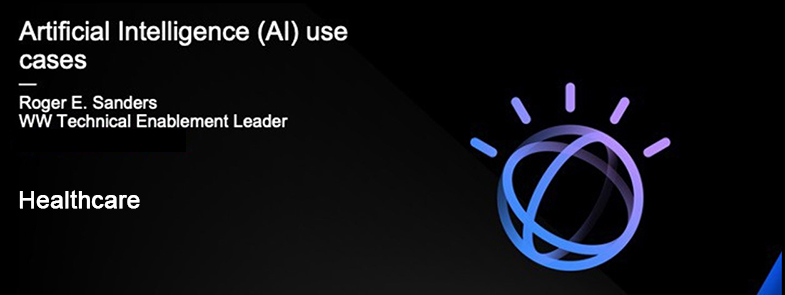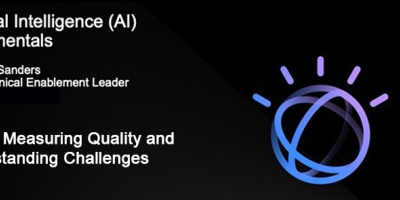According to a study conducted prior to the coronavirus pandemic (in 2019) by the Johns Hopkins University School of Medicine, an estimated 40,000 to 80,000 deaths occur each year in U.S. hospitals because of misdiagnosis.
By Roger Sanders
And an estimated 12 million Americans suffer a diagnostic error each year in a primary care setting – 33% of which result in serious or permanent damage or death. So, there’s no question that more lives could be saved by successfully integrating artificial intelligence (AI), machine learning (ML), and deep learning (DL) into the healthcare ecosystem.
But saving lives is just one benefit; there are nearly endless opportunities to leverage AI, ML, and DL to deliver more precise, efficient, and impactful interventions at exactly the right moment, so patients receive better healthcare faster, and at a lower cost. Because AI can identify meaningful relationships in raw data, it can be used to support diagnosing, treating, and predicting outcomes in many medical situations. AI also has the potential to be applied in almost every field of medicine including drug development, patient monitoring, and personalized patient treatment plans.
Here are some areas where AI can be – or is already being – used in the healthcare industry:
- Augmenting diagnosis and treatment: Whether the aim is to tackle the cause or relieve, and if possible, eliminate symptoms, the primary goal of healthcare is to restore a patient's physical and emotional health. And the correct medical diagnosis serves as the foundation of successful treatment. AI is already being put to use in this area – since 2016, Cleveland Clinic has been collaborating with IBM to work towards providing data-driven personalized healthcare. The system created can analyze thousands of medical papers, using natural language processing (NLP) technology, so it can help a doctor make a diagnosis, and recommend a treatment plan.
- Melanoma detection: Melanoma (the most dangerous form of skin cancer) is hard to detect with the human eye. However, early detection can save lives. And properly trained ML models can analyze the patterns of various skin conditions and distinguish between moles that are benign and moles that are malignant (cancerous). Even though this technology is not being implemented into diagnostic practices yet, AI can perform as well as (and in some cases, better than) human doctors in recognizing skin melanomas, and the technology is only going to get better. This is a great example of how computer vision can assist dermatologists with diagnosis and offer a method for tracking identified moles, over time.
- Medication non-adherence reduction: Non-adherence to prescription medication instructions is a serious healthcare issue today. A patient may decide not to take prescribed medication at all, to use a different dosage from the one prescribed, or to discontinue treatment as soon as they feel better or if they believe the medication is too costly. ML models could use patient information such as age, gender, address, insurance provider, and out-of-pocket expenses, to predict the likelihood that a patient will misuse any drugs prescribed. Armed with this information, healthcare providers can spend more time explaining exactly why it’s important to follow recommendations to those patients who require additional support.
- Medical image analysis: Medical imaging is often the foundation for proper diagnostics. Image analysis, however, is time-consuming – it can take hours to compare 3D medical scans and identify problems. In June 2018, a team of MIT researchers announced they had developed an ML algorithm that can analyze 3D scans up to 1,000 times faster than doctors. The ability to read medical images faster can be lifesaving. And, it has the potential to help surgeons while they are performing an operation. Today, surgeons must bring a patient back to the operating room if they see something wrong when analyzing images taken during a procedure. If it only takes seconds to analyze and compare medical images, surgeons could study changes in real time, and make adjustments as they operate.
- Containing risk of antibiotic resistance: Antibiotic resistance is a growing threat around the world as overuse of these critical drugs fosters the evolution of bacteria that no longer respond to treatments. Multi-drug resistant organisms can wreak havoc in a hospital setting and claim thousands of lives every year. Clostridium difficile (C. difficile) alone accounts for approximately $5 billion US in healthcare costs and claims more than 30,000 lives. ML models could analyze electronic health records (EHRs) to identify infection patterns and highlight patients at risk before they begin to show symptoms. Other ML models could be used to help develop new antibiotics, as well as speed clinical trials.
- Automating administrative tasks: Nurses, doctors, and other healthcare providers spend a lot of their time performing administrative tasks. For example, after examining a patient, a general practitioner must write a detailed report, which may then be used by specialists to better understand a problem or serve as background information for a future visit. If a doctor sees 20 patients a day and spends five minutes writing a report for each, that’s 100 minutes spent writing reports that could be better spent seeing other patients. AI in the form of speech-to-text could be used to transcribe chart notes healthcare providers could then read and edit.
- Narrowing gaps in mental healthcare: An estimated 26% of Americans ages 18 and older (or about 1 in 4 adults) suffer from a diagnosable mental disorder in a given year. And many people suffer from more than one mental disorder at a given time. However, it's often difficult, and costly, to receive mental health treatment. Reducing barriers to mental and behavioral healthcare, especially during the opioid abuse crisis, requires a new approach to connecting patients with services. AI-driven applications and therapy programs will be a significant part of the answer. Smartphone-based cognitive behavioral therapy and integrated group therapy are already showing promise for treating conditions such as depression, eating disorders, and substance abuse. And, researchers are developing AI-based tools that have the backing of clinical trials, that can help in this area.
Sources:
1 in 3 misdiagnoses results in serious injury or death: (Fierce Healthcare)
https://www.fiercehealthcare.com/hospitals-health-systems/jhu-1-3-misdiagnoses-results-serious-injury-or-death
Statistics related to mental health disorders: (Johns Hopkins Medicine)
https://www.hopkinsmedicine.org/health/wellness-and-prevention/mental-health-disorder-statistics
Top 12 Ways Artificial Intelligence Will Impact Healthcare: (Health IT Analytics)
https://healthitanalytics.com/news/top-12-ways-artificial-intelligence-will-impact-healthcare
Top 12 Artificial Intelligence Innovations Disrupting Healthcare by 2020: (Health IT Analytics)
https://healthitanalytics.com/news/top-12-artificial-intelligence-innovations-disrupting-healthcare-by-2020
37 Examples of AI in Healthcare That Will Make You Feel Better About the Future: (Built In)
https://builtin.com/artificial-intelligence/artificial-intelligence-healthcare
10 Powerful Examples of AI used in Healthcare Today: (Referral MD)
https://getreferralmd.com/2019/04/10-powerful-examples-of-ai-used-in-healthcare-today/
Stay Tuned
In the next part of this article series, we’ll examine how AI, ML, and DL are being used in government.




































 More than ever, there is a demand for IT to deliver innovation. Your IBM i has been an essential part of your business operations for years. However, your organization may struggle to maintain the current system and implement new projects. The thousands of customers we've worked with and surveyed state that expectations regarding the digital footprint and vision of the company are not aligned with the current IT environment.
More than ever, there is a demand for IT to deliver innovation. Your IBM i has been an essential part of your business operations for years. However, your organization may struggle to maintain the current system and implement new projects. The thousands of customers we've worked with and surveyed state that expectations regarding the digital footprint and vision of the company are not aligned with the current IT environment. TRY the one package that solves all your document design and printing challenges on all your platforms. Produce bar code labels, electronic forms, ad hoc reports, and RFID tags – without programming! MarkMagic is the only document design and print solution that combines report writing, WYSIWYG label and forms design, and conditional printing in one integrated product. Make sure your data survives when catastrophe hits. Request your trial now! Request Now.
TRY the one package that solves all your document design and printing challenges on all your platforms. Produce bar code labels, electronic forms, ad hoc reports, and RFID tags – without programming! MarkMagic is the only document design and print solution that combines report writing, WYSIWYG label and forms design, and conditional printing in one integrated product. Make sure your data survives when catastrophe hits. Request your trial now! Request Now. Forms of ransomware has been around for over 30 years, and with more and more organizations suffering attacks each year, it continues to endure. What has made ransomware such a durable threat and what is the best way to combat it? In order to prevent ransomware, organizations must first understand how it works.
Forms of ransomware has been around for over 30 years, and with more and more organizations suffering attacks each year, it continues to endure. What has made ransomware such a durable threat and what is the best way to combat it? In order to prevent ransomware, organizations must first understand how it works. Disaster protection is vital to every business. Yet, it often consists of patched together procedures that are prone to error. From automatic backups to data encryption to media management, Robot automates the routine (yet often complex) tasks of iSeries backup and recovery, saving you time and money and making the process safer and more reliable. Automate your backups with the Robot Backup and Recovery Solution. Key features include:
Disaster protection is vital to every business. Yet, it often consists of patched together procedures that are prone to error. From automatic backups to data encryption to media management, Robot automates the routine (yet often complex) tasks of iSeries backup and recovery, saving you time and money and making the process safer and more reliable. Automate your backups with the Robot Backup and Recovery Solution. Key features include: Business users want new applications now. Market and regulatory pressures require faster application updates and delivery into production. Your IBM i developers may be approaching retirement, and you see no sure way to fill their positions with experienced developers. In addition, you may be caught between maintaining your existing applications and the uncertainty of moving to something new.
Business users want new applications now. Market and regulatory pressures require faster application updates and delivery into production. Your IBM i developers may be approaching retirement, and you see no sure way to fill their positions with experienced developers. In addition, you may be caught between maintaining your existing applications and the uncertainty of moving to something new. IT managers hoping to find new IBM i talent are discovering that the pool of experienced RPG programmers and operators or administrators with intimate knowledge of the operating system and the applications that run on it is small. This begs the question: How will you manage the platform that supports such a big part of your business? This guide offers strategies and software suggestions to help you plan IT staffing and resources and smooth the transition after your AS/400 talent retires. Read on to learn:
IT managers hoping to find new IBM i talent are discovering that the pool of experienced RPG programmers and operators or administrators with intimate knowledge of the operating system and the applications that run on it is small. This begs the question: How will you manage the platform that supports such a big part of your business? This guide offers strategies and software suggestions to help you plan IT staffing and resources and smooth the transition after your AS/400 talent retires. Read on to learn:
LATEST COMMENTS
MC Press Online